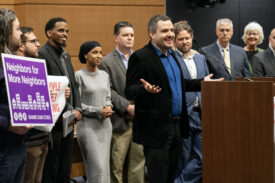The Eugene Register-Guard notes a problem: higher land prices are making it harder for nonprofits to build affordable housing in the city.
The New York Times reports on what America’s biggest city has done about the same problem: an inclusionary zoning program, that lets developers build at higher densities, provided that they set aside some housing units for low-income housing.
Now, if anything, the Big Apple’s problems with providing affordable housing positively dwarf Eugene’s, since both land and construction costs are so much more expensive in New York. But if the Grey Lady is to be believed, inclusionary zoning can harness the high demand for housing to create more housing options for folks who don’t have the money for a luxury condo:
"The traditional equation," said Shaun Donovan, the commissioner of the Department of Housing Preservation and Development, "has been that the stronger the real estate market, the harder it is to provide affordable housing. These programs turn that old equation on its head because the stronger the market, the greater the incentive for developers to use these programs and, therefore, provide affordable housing."
As we’ve mentioned before, hundreds of jurisdictions around the country have used inclusionary zoning to try to boost affordable housing, with mixed results. Here’s hoping that New York’s recent experience can offer some lessons that other places can learn from.








